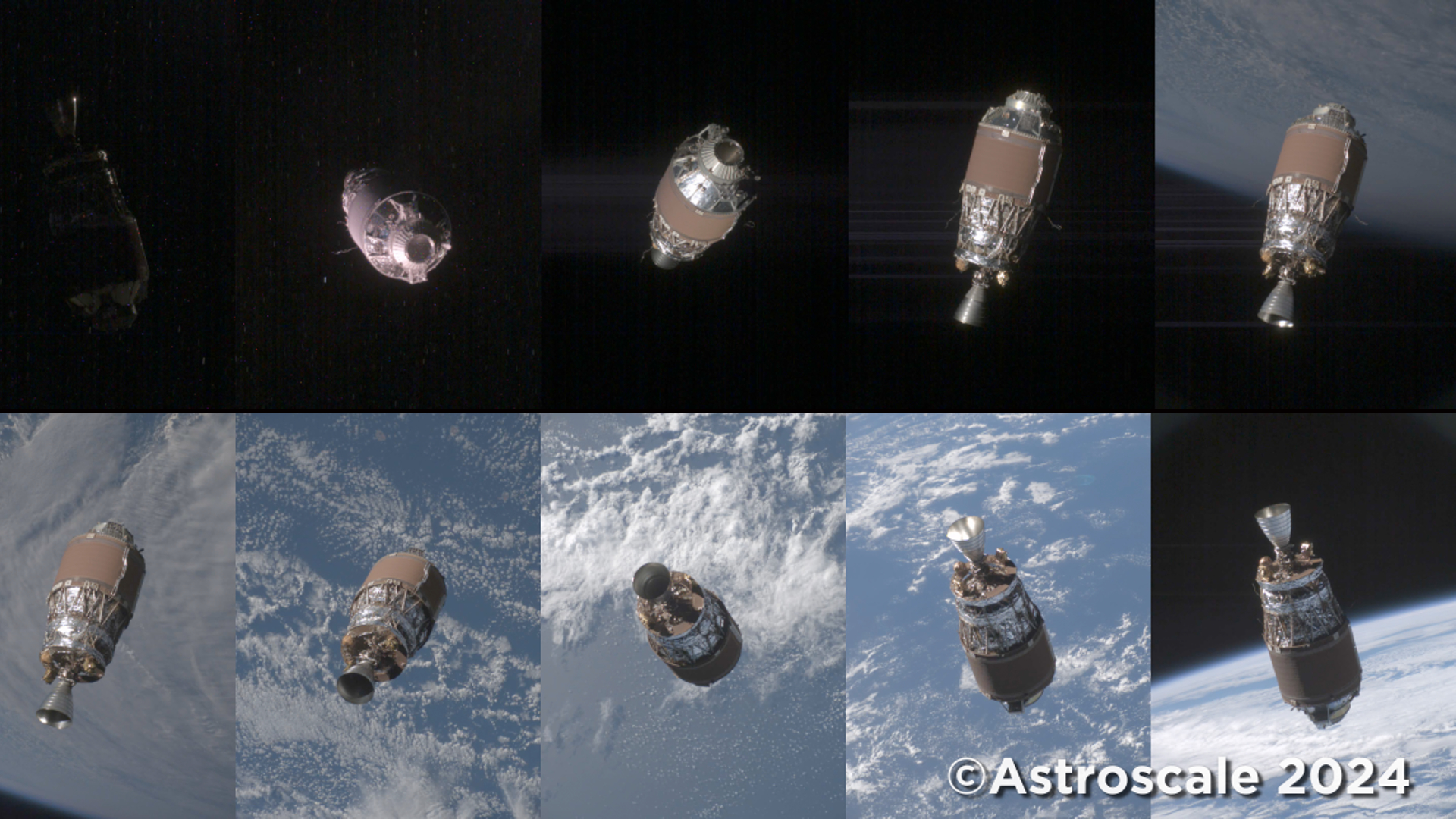Japanese company to deorbit big hunk of space junk by 2029
The mission will target a 3-ton, out-of-control rocket stage.

Japanese space-sustainability company Astroscale just inked a $90 million deal to take a bus-sized rocket stage out of orbit by the end of the decade.
The pioneering project, funded by the Japanese Aerospace Exploration Agency (JAXA), is a continuation of Astroscale's ADRAS-J mission, which recently completed an up-close orbital inspection of a 12-year-old upper stage of a Japanese H-2A rocket.
The new mission, called ADRAS-J2, will grab the 3-ton, 36-foot-long (11 meters) rocket stage using a robotic arm and pull it into Earth's atmosphere to burn up, demonstrating a critical space cleanup technology.
The H-2A upper stage, which has been tumbling in a 370-mile-high (600 kilometers) orbit since deploying the greenhouse gas-observing satellite GOSAT in 2009, is one of hundreds of spent rocket bodies in near-Earth space.
The out-of-control nature and the age of the rocket body pose challenges for its removal, but the ADRAS-J inspection showed that the rocket's payload adapter, which will be used to grab the rocket, is intact.
"Unprepared objects in orbit pose an additional challenge, as they have not been prepared with any technologies that enable docking or potential servicing or removal," Astroscale said in a statement.
Related: Space-junk scout captures amazing fly-around footage of discarded rocket in orbit (video)
Get the Space.com Newsletter
Breaking space news, the latest updates on rocket launches, skywatching events and more!
The out-of-control nature and the age of the rocket body pose challenges for its removal, but the ADRAS-J inspection showed that the rocket's payload adapter, which will be used to grab the rocket, is intact.
"Unprepared objects in orbit pose an additional challenge, as they have not been prepared with any technologies that enable docking or potential servicing or removal," Astroscale said in a statement.
Astroscale has two other space debris removal missions in the works. In July, the Tokyo-based company signed a contract with satellite operator Eutelsat OneWeb to remove a OneWeb satellite fitted with a magnetic docking plate from orbit in 2027.
Another Astroscale concept spacecraft — one fitted with a robotic arm — is currently being considered by the U.K. Space Agency to potentially remove two old British satellites.
The ADRAS-J2 mission could launch as early as 2027, according to the Space Assigned Numbers Authority. The European Space Agency (ESA) is also working on a mission that aims to remove a piece of space junk. That mission, called ClearSpace-1, however, will target the much smaller, 207-pound (94 kilograms) Proba-1 satellite. ClearSpace-1 was originally intended to remove a 247-pound (112 kg) payload adapter from a European Vega rocket, but ESA decided to switch for Proba-1 after the original target was damaged by an orbital collision in August 2023. The mission will not launch before 2028.
Astroscale also tested some of its key technologies on a project called ELSA-M. That mission, concluded in January, repeatedly captured a simulated piece of space junk using a magnetic system.
Space debris is a major concern for the space industry. According to ESA, some 40,500 pieces of space junk larger than 4 inches (10 cm) hurtle through space. These include old satellites, spent rocket stages, objects discarded from the International Space Station and fragments generated in collisions and explosions. In addition to those, 1.1 million objects between 0.4 and 4 inches (1 to 10 cm) in size are scattered through near-Earth space. The number of objects smaller than 0.4 inches (1 cm) is estimated at more than 130 million.
This junk circles Earth at incredible speeds, threatening to damage everything in its way. With the number of operational satellites rising as well, experts worry that collisions will soon become unpreventable, as Earth-based radars only see the larger space debris fragments.
Collisions between larger pieces of space debris are especially worrying, as they create massive numbers of fragments. Active space debris removal is therefore critical to keep the space environment safe for future operations, many sustainability experts say. An out-of-controlled cascade of collisions, called the Kessler Syndrome, could render it unusable for decades.
Join our Space Forums to keep talking space on the latest missions, night sky and more! And if you have a news tip, correction or comment, let us know at: community@space.com.

Tereza is a London-based science and technology journalist, aspiring fiction writer and amateur gymnast. Originally from Prague, the Czech Republic, she spent the first seven years of her career working as a reporter, script-writer and presenter for various TV programmes of the Czech Public Service Television. She later took a career break to pursue further education and added a Master's in Science from the International Space University, France, to her Bachelor's in Journalism and Master's in Cultural Anthropology from Prague's Charles University. She worked as a reporter at the Engineering and Technology magazine, freelanced for a range of publications including Live Science, Space.com, Professional Engineering, Via Satellite and Space News and served as a maternity cover science editor at the European Space Agency.
-
Meteoric Marmot These companies are going about it all wrong. What they need to do is replicate Mega Maid from the Spaceballs universe. :)Reply









